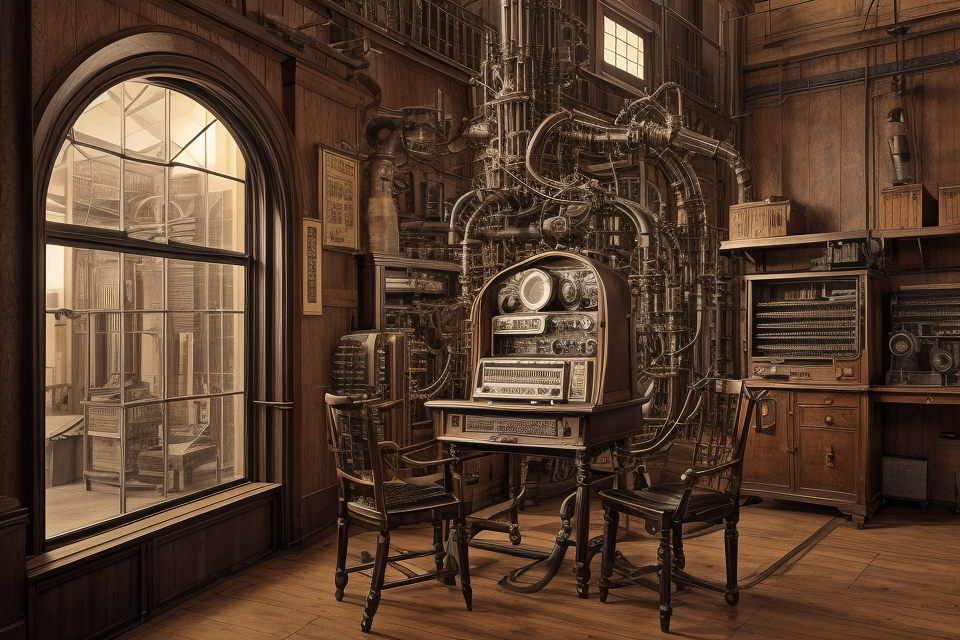The computer, that ubiquitous machine that has revolutionized the world as we know it, had its genesis in the mind of a brilliant mathematician and inventor, Charles Babbage. But where exactly was this groundbreaking invention born? Join us as we embark on a journey to explore the origins of the computer and uncover the story behind Charles Babbage’s pioneering work. Get ready to be captivated by the fascinating tale of how the computer came to be!
The computer was invented by Charles Babbage in the early 19th century in England. Babbage was a mathematician and inventor who is credited with designing the first mechanical computer, known as the Analytical Engine. This machine was designed to be able to perform complex calculations and was capable of being programmed using punch cards. Although the Analytical Engine was never built during Babbage’s lifetime, it laid the foundation for the development of modern computers and is considered to be an important milestone in the history of computing.
The Early Life and Work of Charles Babbage
Education and Early Interests
Charles Babbage was born in London, England in 1791. He was the son of a prominent banker and received a rigorous education from a young age. His formal education began at a private school in Enfield, where he demonstrated a keen interest in mathematics and science. This interest was further cultivated by his father, who encouraged his son’s curiosity and provided him with access to scientific instruments and books.
Babbage’s early influences were varied and included the works of Sir Isaac Newton, Leonhard Euler, and Daniel Bernoulli, all of whom made significant contributions to the fields of mathematics and physics. Babbage was particularly drawn to the work of the French mathematician, Pierre-Simon Laplace, whose “Mécanique Céleste” provided a comprehensive analysis of the gravitational forces that govern the motion of celestial bodies.
Babbage’s passion for mathematics and engineering was further fueled by his studies at the University of Cambridge, where he attended Trinity College. It was during this time that he began to develop his ideas about the potential of computers and the ways in which they could be used to solve complex mathematical problems.
The Analytical Engine
The Concept of the Analytical Engine
The Analytical Engine was a proposed mechanical general-purpose computer designed by Charles Babbage in the early 19th century. It was intended to be able to perform any calculation that could be expressed in an algorithm. The concept of the Analytical Engine was based on the idea of using a set of numerical values, called variables, which could be manipulated according to a set of rules, or operations, in order to solve a problem.
Design and Functionality of the Analytical Engine
The Analytical Engine was designed to be a steam-powered machine that could perform calculations using a system of gears and levers. It had a memory unit, consisting of a set of cylinders that could store the variables, and a central processing unit (CPU) that could perform the operations on the variables. The machine was capable of performing addition, subtraction, multiplication, and division, as well as more complex operations such as finding the roots of equations and solving differential equations.
Differences between the Analytical Engine and Modern Computers
Although the Analytical Engine was never built, it is considered to be an important precursor to the modern computer. The design of the machine was based on the idea of a stored-program computer, in which the instructions for the CPU are stored in memory along with the data. This concept is still used in modern computers, and it is one of the key differences between the Analytical Engine and early mechanical calculators, which could only perform a single operation at a time. The Analytical Engine was also the first machine to propose the use of a punch card system for inputting data, which was later adopted in the design of the Jacquard loom and the early electronic computers.
The Difference Engine
The Concept of the Difference Engine
Charles Babbage, a mathematician and inventor, is considered the “father of the computer” due to his pioneering work in the field of computing. One of his most significant contributions was the invention of the Difference Engine, a mechanical device that could perform complex mathematical calculations.
The concept of the Difference Engine was inspired by the need to produce accurate mathematical tables for navigation and astronomy. At the time, these tables were created manually, a time-consuming and error-prone process. Babbage realized that a mechanical device could automate this process, producing more accurate tables in a fraction of the time.
Design and Functionality of the Difference Engine
The Difference Engine was a mechanical device that used a series of gears and levers to perform mathematical calculations. It was designed to perform operations such as addition, subtraction, multiplication, and division, making it a versatile tool for scientific and engineering applications.
The engine was based on the concept of finite differences, which involves approximating the value of a function at a particular point by calculating the difference between nearby points. This method was well-suited to the mechanical implementation of the Difference Engine, allowing it to perform complex calculations with a high degree of accuracy.
Importance of the Difference Engine in the Development of the Computer
The Difference Engine was a groundbreaking invention that laid the foundation for the modern computer. It demonstrated the potential of mechanical devices to perform complex calculations, paving the way for the development of more advanced computing machines.
Moreover, the Difference Engine was the first computing device to be designed with the principles of automation and programmability in mind. Babbage’s invention of the Analytical Engine, a proposed mechanical general-purpose computer, built upon the concepts of the Difference Engine, laying the foundation for the development of modern computers.
In conclusion, the Difference Engine was a pioneering invention that marked the beginning of the computer revolution. It demonstrated the potential of mechanical devices to perform complex calculations and laid the foundation for the development of more advanced computing machines.
The Search for the Birthplace of the Computer
Theories on the Location of the First Computer
Various theories have been proposed regarding the location of the first computer. One of the most popular theories is that the first computer was built in the United Kingdom. This theory is supported by the fact that Charles Babbage, who is widely regarded as the “father of the computer”, was a British citizen.
Another theory suggests that the first computer was actually built in the United States. This theory is based on the work of Herman Hollerith, who developed the first practical electronic tabulating machine in the 1890s. Some historians argue that Hollerith’s machine was the first true computer, as it was capable of performing complex calculations and was controlled by punched cards.
There is also a theory that the first computer was built in Germany. This theory is based on the work of Konrad Zuse, who built the first programmable computer, the Z1, in 1936. However, some historians argue that the Z1 was not a true computer, as it did not have a central processing unit (CPU) and could not perform calculations.
Other theories suggest that the first computer was built in other parts of the world, such as Russia or China. However, there is little evidence to support these claims.
Overall, the location of the first computer remains a matter of debate among historians and computer scientists. However, it is clear that the development of the computer was a global effort, with many inventors and researchers contributing to its evolution over the years.
The Hidden History of the Computer
- Lack of documentation on the early history of the computer
- Limited records of the time period
- Limited understanding of the context of the invention
- Challenges in tracing the origins of the computer
- The difficulty in tracing the evolution of the computer from its early beginnings
- The complexity of piecing together information from different sources and individuals.
The Babbage Engine: The First Computer?
The Claim of the Babbage Engine as the First Computer
Arguments in favor of the Babbage Engine as the first computer
The Babbage Engine, a theoretical mechanical general-purpose computer designed by Charles Babbage in the early 19th century, is often considered the first computer. There are several arguments in favor of this claim:
- The Babbage Engine was designed to perform any calculation that could be expressed in an algorithm, making it a general-purpose computer. This contrasts with earlier machines, such as the Antikythera Mechanism, which were specialized for specific tasks.
- Babbage’s design included features that are now considered fundamental to computer architecture, such as the use of punch cards for input and a printing mechanism for output.
- The Babbage Engine was designed to be controlled by a formal language, which would have allowed users to program it without needing to understand the intricate mechanical workings of the machine.
Evidence supporting this claim
There is a significant amount of evidence to support the claim that the Babbage Engine was the first computer:
- Babbage’s designs and plans for the engine were highly detailed and thorough, including diagrams, calculations, and even a manual for operating the machine.
- Babbage’s work on the Engine was influential in the development of modern computer science, and his ideas and designs were later incorporated into the development of electronic computers.
- The Babbage Engine was designed to be capable of being programmed and controlled by a formal language, making it a general-purpose computer in the same way that modern computers are.
Overall, the evidence supports the claim that the Babbage Engine was the first computer, and it is considered by many to be the precursor to modern computing technology.
The Contributions of Charles Babbage to the Development of the Computer
- Babbage’s designs and concepts as the foundation of modern computing
- Analytical Engine: a proposed mechanical general-purpose computer
- Designed to be able to perform any calculation that could be expressed in an algorithm
- Contains the concepts of conditional branching and loops, which are essential for programming
- Difference Engine: an early mechanical general-purpose computer
- Able to tabulate and print polynomial equations
- Improved upon previous mechanical calculators
- Analytical Engine: a proposed mechanical general-purpose computer
- The impact of Babbage’s work on the development of the computer
- Inspired the development of modern computers by laying the foundation for programming languages and algorithms
- Influenced other early computer pioneers such as Ada Lovelace and Alan Turing
- The ideas behind the Analytical Engine were later implemented in the first electronic computers
The Significance of the Babbage Engine Today
The Legacy of Charles Babbage
The Influence of Babbage’s Work on Modern Computing
- Babbage’s designs and concepts served as the foundation for the development of the modern computer
- His work on the Analytical Engine laid the groundwork for the development of the stored-program concept, which is a fundamental principle of modern computing
- The idea of a central processing unit (CPU) and memory unit, which are essential components of modern computers, can be traced back to Babbage’s designs
- Babbage’s work also influenced the development of early computer languages, such as Fortran and Cobol
The Importance of Babbage’s Designs and Concepts in the Development of the Computer
- Babbage’s designs and concepts were ahead of their time and were not fully realized until decades later
- The Analytical Engine was not built during Babbage’s lifetime, but his plans and designs were used as a reference for early computer builders in the 20th century
- Babbage’s work served as a source of inspiration for early computer scientists and engineers, including Ada Lovelace, who is often considered to be the first computer programmer
- Babbage’s designs and concepts helped to establish the field of computer science and laid the groundwork for the development of modern computing technology
The Future of the Babbage Engine
The Babbage Engine, though never fully realized in its time, holds great significance in the modern computing world. The potential for the Babbage Engine to revolutionize computing is still being explored and studied today. In fact, some experts believe that recreating the Babbage Engine could hold the key to advancing modern computing technology.
The ongoing interest in the Babbage Engine and its potential for modern computing
There is ongoing interest in the Babbage Engine and its potential for modern computing. Many experts believe that the Babbage Engine could have been the first computer, and its design and principles have been studied extensively in recent years. Some of the key features of the Babbage Engine that make it significant today include:
- The use of punch cards, which were later used in the design of the first modern computers
- The use of a central processing unit (CPU), which is still the basis for modern computing
- The use of algorithms, which are still the foundation of computer programming today
The possibility of recreating the Babbage Engine in the future
The possibility of recreating the Babbage Engine in the future is an area of active research and development. Some experts believe that the Babbage Engine could be recreated using modern materials and manufacturing techniques, while others believe that it may be impossible to recreate the machine as it was designed in the 19th century.
However, the possibility of recreating the Babbage Engine has sparked renewed interest in the machine and its potential for modern computing. The Babbage Engine is an important part of the history of computing, and its legacy continues to inspire and inform modern computing technology.
FAQs
1. Where was the computer invented by Charles Babbage?
Charles Babbage invented the computer in London, England. Specifically, he designed the first mechanical general-purpose computer, the Analytical Engine, while living in London. This was a revolutionary machine that could perform any calculation that could be expressed in an algorithm.
2. What was the inspiration behind the Analytical Engine?
Charles Babbage was inspired by the need for more efficient calculation methods. He was frustrated with the slow and error-prone process of using manual calculation methods, such as those used in astronomy and mathematics. He wanted to create a machine that could perform calculations automatically and with greater accuracy.
3. When was the Analytical Engine built?
The Analytical Engine was never actually built during Charles Babbage’s lifetime. He spent many years designing and refining the machine, but funding and resources were never secured to bring it to life. It wasn’t until decades later that the first electronic computers were built, which were inspired by Babbage’s designs.
4. What was the significance of the Analytical Engine?
The Analytical Engine was significant because it represented the first step towards the modern computer. It was a general-purpose machine, meaning it could perform any calculation that could be expressed in an algorithm. This was a departure from earlier computing machines, which were specialized for specific tasks. The concept of a general-purpose computer was revolutionary and paved the way for the development of modern computing.
5. What happened to the plans for the Analytical Engine after Charles Babbage’s death?
After Charles Babbage’s death, his son, Henry Babbage, oversaw the publication of his father’s work. The plans for the Analytical Engine were published in a series of articles in the 1860s, and the machine gained a significant following among scientists and mathematicians. The designs for the Analytical Engine influenced the development of early electronic computers, and it is now considered an important milestone in the history of computing.



